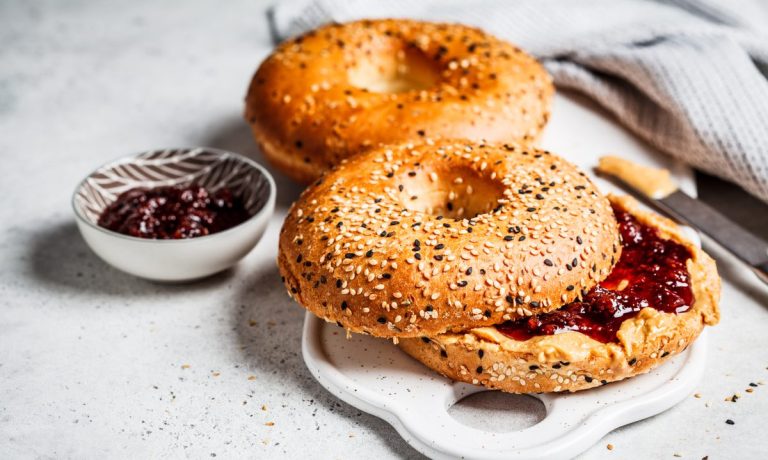
The turn to eCommerce in the early months of the pandemic presented an opportunity for new kinds of businesses to flourish. For many beloved local eateries, the pandemic was devastating, drying up the stream of tourists or even hometown-ers making the trip to the shop.
However, as the in-person business struggled, a new revenue stream emerged for those with enough savvy and enough brand recognition to take advantage of it: nationwide shipping. Food gifting platform Goldbelly saw sales soar, and soon restaurant delivery giant DoorDash got into the mix, launching its own nationwide shipping business in November.
Read more: DoorDash Aims to Edge out Goldbelly With ‘Nationwide Shipping’ Launch
“In a pre-pandemic time, 40% of our nationwide shipping business was in the month of December,” said Jay Rushin, CEO of H&H Bagels, a New York City-based bagel chain that ships nationwide through its direct channels, through Goldbelly and through DoorDash. “Starting in March of 2020, we were effectively doing December business every single month of the year because of the pandemic, and we’ve probably only given 10% of that back in the last six months. That nationwide shipping business is still five to six times the size it was pre-pandemic versus current, so that’s a sustainable business in our mind.”
A Long Time Coming
While some food sellers have gotten into nationwide shipping since third parties such as Goldbelly and DoorDash lowered the barrier of entry, H&H has actually been in the space for significantly longer, with these new options providing the channel with a welcome boost.
“That was a business that was effectively slowly declining 10 years ago, as we had a primitive web ordering system,” Rushin said.
He noted that upward-trending FedEx and UPS rates for overnight orders were increasing each year, making it difficult to grow the business, adding the combination of the company’s 2017 deal with Goldbelly and the 2020 pandemic boost has revitalized the service, with the extra boost last year of DoorDash’s shipping launch.
The brand is in many ways uniquely set up for success in nationwide shipping. Not only does it sell a food that is strongly associated with the location in which the chain is headquartered (bagels are, after all, a New York staple), and not only has the brand gained significant name recognition within the city and beyond, but it also sells a product that is well-suited to the model.
“Bagels in general travel well, whether it’s down the block or coast to coast,” said Rushin.
Channel Surfing
Certainly, online food purchasing has taken off in recent years in a permanent way. For example, research from PYMNTS’ 2021 study Consumers And The New Retail Landscape, part of the Pandenomics series, found that the vast majority of consumers who shifted their restaurant, grocery and retail habits online during the pandemic plan to maintain these behaviors even once contagion concerns subside completely.
Read more: 75% of Shoppers Will Keep Digital Habits After Pandemic
Now, for businesses selling online, it is a matter of reaching the right consumers. Rushin said that each of the company’s three nationwide shipping channels — Goldbelly, DoorDash and direct ordering — attract a slightly different customer. For example, while Goldbelly has a smaller customer base, its shoppers are less likely to get thrown by sticker shock.
“We’ve got a much broader reach with DoorDash, but it’s an expensive product relative to getting a single meal delivered because you’re paying for the product and overnight shipping,” he said. “Goldbelly customers clearly expect that — that’s why they’re on Goldbelly.”
Still, he noted that, in the nationwide shipping category, DoorDash has, in these past few months, “gained some share for sure.”
He added that, while the company has invested some resources in marketing its direct ordering channels, H&H attempts “to be channel agnostic with all of our businesses,” prioritizing acquiring customers across channels above driving adoption of its direct channels.
The Franchise Tradeoff
Currently, the brand is engaging in an effort that may change the shape of its nationwide shipping business in the near future. The company launched a franchising program several months ago, which could dilute the brand’s geography-specific appeal.
“With the introduction of franchising around the country, you could see where we could lose some of our nationwide shipping customers because they’re going to start going to bricks and mortars,” he said.
Still, he argued that demand will remain in areas that do not have a franchise location or that prove unable to support one. The brand’s nationwide shipping business is helped by the fact that it does not require many resources to sustain, such that it can only boost the chain’s profitability with little to no risk.
“Nationwide shipping is basically a part of our wholesale business,” Rushin said. “It’s really no actual capex other than labor … As volume goes up, we throw more labor at it. As volume goes down, we take labor away. So, there’s no real problems on that side.”